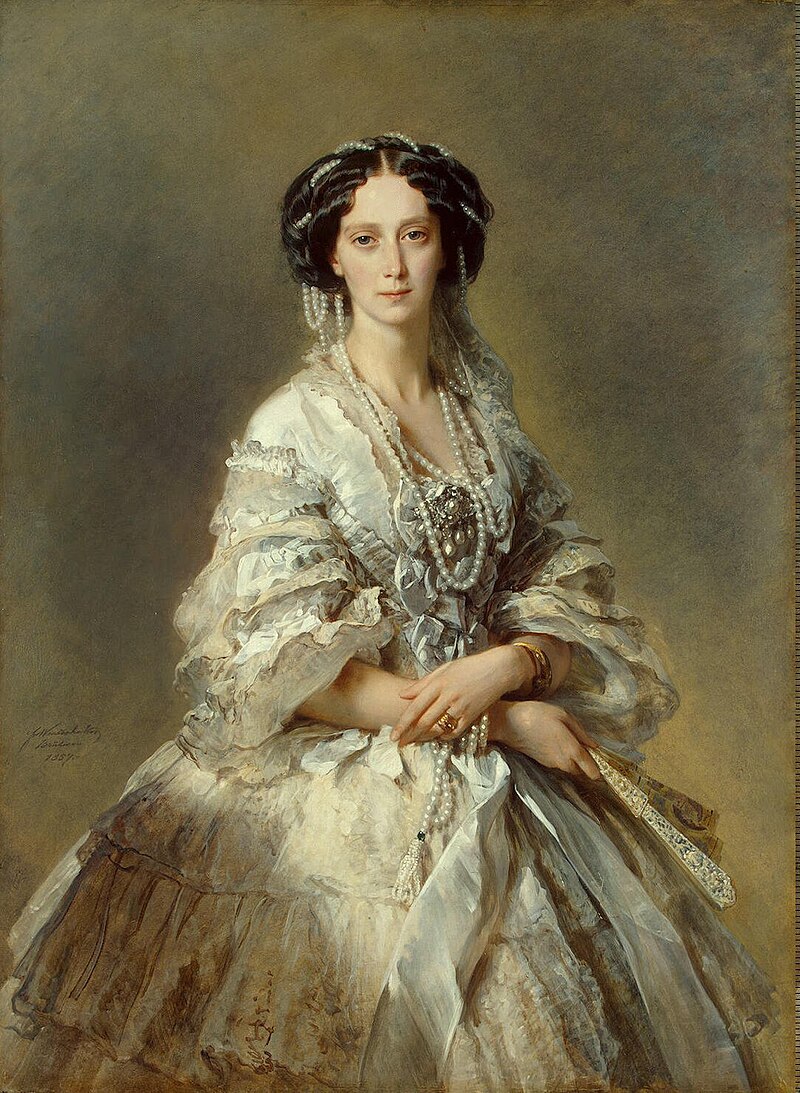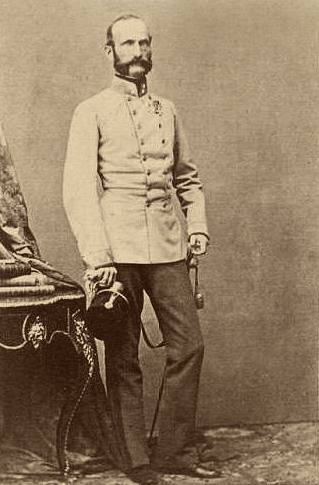by Scott Mehl © Unofficial Royalty 2019

Julia Hauke, Princess of Battenberg; Credit – Wikipedia
Julia Hauke, Princess of Battenberg was the wife of Prince Alexander of Hesse and by Rhine, and the founder of the Battenberg branch of the Grand Ducal family of Hesse and by Rhine. She was born Julia Therese Salomea Hauke on November 24, 1825, in Warsaw, Poland, the youngest daughter of Count Johann Moritz Hauke and Sophie Lafontaine. Among her ten siblings was a sister Catarina who later became the mistress of Paul Friedrich, Grand Duke of Mecklenburg-Schwerin.
Julia’s father was a distinguished soldier, serving with Napoleon’s Polish Legions, and then with the armies of Poland and the Duchy of Warsaw. He joined the army of Congress Poland in 1814, reaching the rank of General in 1828. In 1829, Nicholas I, Emperor of All Russia appointed him Deputy Minister of War of Congress Poland. The following year, he was killed during the November Uprising of 1830. While riding beside the carriage carrying his wife and younger children, Hauke encountered a group of rebel cadets who wanted him to lead them in their revolt. He rebuked them and ordered them back to their quarters. Instead, they opened fire on him, killing him almost instantly. His wife, suffering from shock, died soon afterward, and their younger children – including Julia – were made wards of the Russian Emperor.

Empress Maria Alexandrovna of Russia. source: Wikipedia
Raised at the Russian Imperial Court, Julia later became a lady-in-waiting to Grand Duchess Maria Alexandrovna, the wife of the future Alexander II, Emperor of All Russia. The Grand Duchess was born Princess Marie of Hesse and by Rhine, and was the younger sister of Julia’s future husband Alexander. He had accompanied his sister to Russia for her wedding in 1841, became close to his new brother-in-law, and decided to stay in Russia. Alexander became a prominent member of the Imperial Court and served in the Russian military. The Emperor considered Alexander as a possible husband for one of his nieces, but Alexander had already fallen in love with Julia. The Emperor refused to allow a marriage between them, but the couple was determined to marry. Eloping from St. Petersburg, they made their way to Breslau in Silesia, where they married on October 28, 1851. At the time, Julia was already six months pregnant with their first child.

Prince Alexander of Hesse and by Rhine. source: Wikipedia
As their marriage was morganatic, Julia did not become a Princess of Hesse and by Rhine. Instead, her brother-in-law, Grand Duke Ludwig III of Hesse and by Rhine, created her Countess of Battenberg, with the style Illustrious Highness. Her children took their titles from her, becoming Counts and Countesses of Battenberg. Seven years later, the Grand Duke elevated Julia and her children to the rank of Prince/Princess, with the style Serene Highness. However, they remained ineligible for the Grand Ducal throne.
Julia and Alexander had five children:
- Princess Marie of Battenberg (1852-1923) – married Gustav, Prince of Erbach-Schönberg, had issue
- Prince Louis of Battenberg (1854-1921) – married Princess Victoria of Hesse and by Rhine, had issue
- Prince Alexander of Battenberg (1857-1893) – married Johanna Loisinger, had issue
- Prince Heinrich of Battenberg (1858-1896) – married Princess Beatrice of the United Kingdom, had issue
- Prince Franz Joseph of Battenberg (1861-1924) – married Princess Anna of Montenegro, no issue

Julia (far left) with some of her family, c1864. source: Wikipedia. (seated L-R: Princess Elisabeth of Prussia, wife of Prince Karl of Hesse and by Rhine; Princess Marie of Hesse and by Rhine, Empress Maria Alexandrovna of Russia; Princess Alice of the United Kingdom, later Grand Duchess of Hesse and by Rhine) (standing L-R: Julia, Princess of Battenberg; Prince Karl of Hesse and by Rhine; Prince Heinrich of Hesse and by Rhine; the future Grand Duke Ludwig IV of Hesse and by Rhine; Gustav, Prince of Vasa; Prince Alexander of Hesse and by Rhine)
Julia and her husband returned to the Grand Duchy of Hesse and by Rhine, where they lived at the Alexander Palace in Darmstadt, and later at Schloss Heiligenberg in nearby Jugenheim. However, Alexander received a commission from the Austrian Army, and they spent many years in Austria and Italy, depending on where he was stationed. For this reason, each of their children was born in a different place.

In the foreground, the graves of Alexander and Julia; Photo Credit – Wikipedia
Julia’s husband died in 1888 and was buried in the Grand Ducal Mausoleum in the Rosenhöhe in Darmstadt, Grand Duchy of Hesse and by Rhine, now in the German state of Hesse. However, as Julia was not of equal rank, she would not be permitted to be buried beside him. Therefore, she oversaw the construction of a new mausoleum, built in the grounds of Schloss Heiligenberg. Upon the completion of the new mausoleum, Alexander’s remains were moved there in 1894. The following year, On September 19, 1895, Julia died at Schloss Heiligenberg at the age of 69. She was buried beside her husband in the mausoleum on the grounds of their beloved Heiligenberg. In 1902, the mausoleum was converted to a memorial chapel, and the remains of Julia and Alexander were moved to graves just outside the building.
This article is the intellectual property of Unofficial Royalty and is NOT TO BE COPIED, EDITED, OR POSTED IN ANY FORM ON ANOTHER WEBSITE under any circumstances. It is permissible to use a link that directs to Unofficial Royalty.
